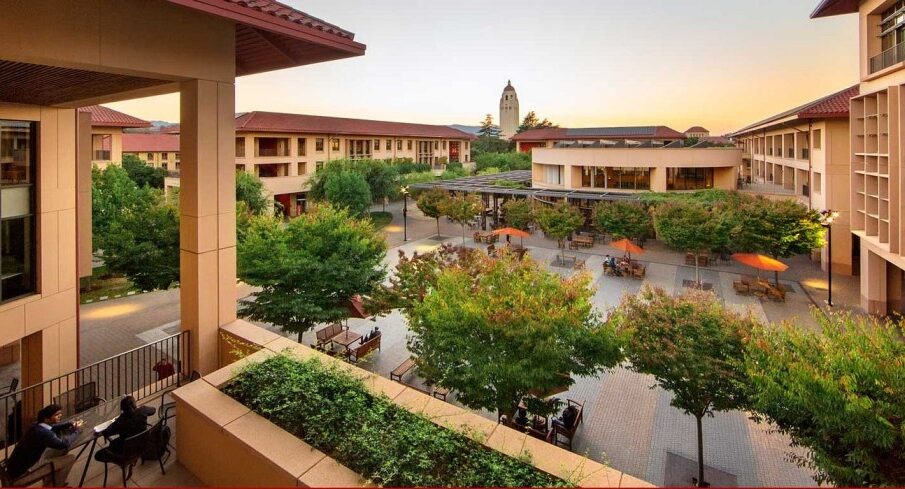Stanford MBA Review: Class Profile, Eligibility, Tuition Fee & More

Stanford Graduate School of Business (GSB) offers a Master of Business Administration (MBA) program that is renowned for its rigorous academic curriculum, exceptional faculty, and innovative approach to business education. With a mission to create ideas that deepen and advance the understanding of management, Stanford GSB prepares leaders who will change the world.
This blog explored various facets of the Stanford MBA program, including class profiles, fees and financing, eligibility criteria, program curriculum, employment outcomes, and what makes Stanford GSB unique.
Class Profile of Stanford MBA
The Stanford Graduate School of Business (GSB) is renowned for its highly selective and diverse MBA program. The class exemplifies the school’s commitment to attracting exceptional individuals from around the world. Let’s take a closer look at the key statistics:
| Metric | Value |
| Average Age | 29 |
| Pre-MBA Industry MBA 2025 | Investment 19% Consulting 17% Technology 13% Financial 5% Healthcare 7% |
| GMAT Scores | 630 – 790 |
| GPA Average | 3.77 |
| Average Work Experience | 5 years |
| Women in the Class | 46% |
| International Citizens | 36% |
| Countries Represented | 55 |
Fees and Financing
The Stanford University MBA fees is significant, but the school offers a range of financial aid options to support students.
| Expense | Cost (per year) |
| Tuition | $76,950 |
| Room and Board | $32,000 |
| Other Expenses | $12,000 |
| Total Cost of Attendance | $120,950 |
Stanford GSB provides various scholarships, fellowships, and loan programs to help students finance their education. The school also offers the Knight-Hennessy Scholars program, which provides full funding for graduate studies.
Stanford MBA Eligibility Criteria
To be eligible for the Stanford MBA program, applicants must meet the following requirements:
- Bachelor’s degree or equivalent
- GMAT or GRE scores
- English language proficiency (for non-native speakers)
- Minimum of 2 years of full-time work experience
- Demonstrated leadership, analytical, and communication skills
The admissions committee evaluates applicants holistically, considering their academic background, professional experience, extracurricular activities, and potential to contribute to the diverse Stanford community.
Stanford MBA Program and Curriculum
The Stanford MBA program is designed to provide a comprehensive and flexible curriculum that fosters intellectual growth and leadership development. The program spans two years, with the first year focusing on core courses and the second year allowing for customization through electives and experiential learning opportunities.
First-Year Curriculum:
- Core Courses: Cover fundamental areas such as General Management Perspectives, Financial Accounting, Managerial Skills, Marketing, Strategy, and Global Context of Management.
- Global Experience Requirement: Students must complete a global experience to gain international exposure.
Second-Year Curriculum:
- Electives: A wide range of electives allows students to tailor their learning to specific interests and career goals.
- Experiential Learning: Opportunities include the Leadership Labs, Startup Garage, and the Public Management Program.
- Joint and Dual Degree Programs: Students can pursue joint degrees with other schools at Stanford, such as Law, Education, Engineering, and Medicine.
Employment Upon Graduation
Stanford GSB graduates are highly sought after by top companies and organisations worldwide. The school’s strong industry connections and career support services contribute to the impressive employment outcomes.
| Metric | Value |
| Employed 3 Months Post-Graduation | 96% |
| Median Base Salary | $158,400 |
| Median Signing Bonus | $30,000 |
The most popular industries for Stanford MBA graduates include Consulting, Technology, Financial Services, and Venture Capital/Private Equity.
Why is Stanford Unique?
Stanford GSB stands out for several reasons that contribute to its unique and transformative MBA experience:
Small and Selective Class Size
With a class size of around 400 students, the Stanford MBA program offers a highly personalised and intimate learning experience, fostering close-knit relationships and collaboration among classmates.
Emphasis on Innovation and Entrepreneurship
Stanford’s location in the heart of Silicon Valley, combined with its strong entrepreneurial culture, provides unparalleled opportunities for students to explore and launch their own ventures.
Interdisciplinary Approach
The Stanford MBA curriculum encourages students to think beyond traditional business boundaries, leveraging the resources and expertise of other Stanford schools, such as the School of Engineering, the School of Medicine, and the School of Law.
Experiential Learning
The school’s Action Learning Program and various hands-on projects allow students to apply their knowledge to real-world business challenges, developing practical skills and problem-solving abilities.
Diverse and Inclusive Community
Stanford GSB attracts a diverse student body from various backgrounds, nationalities, and industries, creating a rich and dynamic learning environment that celebrates different perspectives and experiences.
Exceptional Faculty and Resources
Stanford GSB boasts a world-class faculty, with renowned scholars and industry leaders who are dedicated to teaching and mentoring students. The school also provides access to cutting-edge research, state-of-the-art facilities, and a vast alumni network.
Conclusion
The Stanford MBA program offers a unique and enriching experience that equips students with the skills, knowledge, and network needed to excel in their careers and make a positive impact on the world. With its rigorous curriculum, diverse community, and focus on leadership development, Stanford GSB continues to be a premier destination for aspiring business leaders. Whether you’re looking to advance in your current career, pivot to a new industry, or start your own venture, a Stanford MBA can be the catalyst for achieving your professional and personal goals.
Leave a reply
You must be logged in to post a comment.














